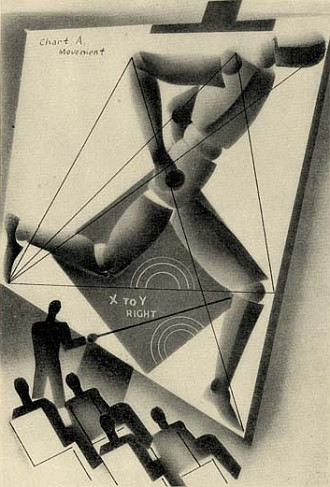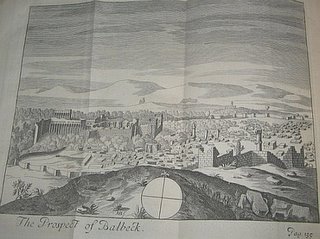




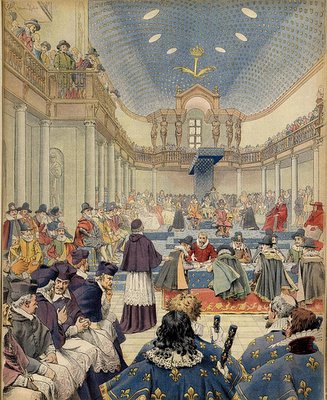
Lavish and rich are the adjectives that come to mind when attempting to describe these exceptional 1901 illustrations by Maurice Leloir (1851-1940). Chomotypogravures are a species of image prints in which colours are reproduced as a series of dots - an early form of colour printing.
Leloir produced 34 full page watercolour illustrations to accompany the text by Théodore Cahu about the life of the 17th century French religious and political figure, Cardinal Richelieu. Although I've posted large-ish images, it's worth seeing the available selection at full size. There are some further examples at ebay also. I'll return to Leloir in the future - he left a sizeable body of book illustrations.
Armand Jean du Plessis, Cardinal Richelieu at Wikipedia.
Saturday, February 18, 2006
Richelieu
Friday, February 17, 2006
Agricoltura
 'Riporta l'orientamento, indicato coi nomi dei venti,
'Riporta l'orientamento, indicato coi nomi dei venti,delle diverse operazioni di aratura consigliate per la
preparazione del terreno alla coltura del grano dopo maggese.'
 'Prospetto di un campo coi diversi lavori che vengono eseguiti
'Prospetto di un campo coi diversi lavori che vengono eseguitialla semina. Presa III: distribuzione della semente; Presa II:
ricopertura della semente con aratri trainati da buoi; Presa I:
sistemazione finale del terreno dopo la semina tale da garantire
lo sgrondo delle acque. Le diverse operazioni sono descritte
nelle note con la terminologia in uso alla fine del '700.'
 'Dimensionamento e suddivisione di un'aia (
'Dimensionamento e suddivisione di un'aia ( 'Illustra i criteri da seguire per la costituzione
'Illustra i criteri da seguire per la costituzionedi un'aia che puo essere formata da 2, 4, 6, 8 suoli
a seconda della previsione dell'entita del raccolto.'
 'Prospetto di quattro suoli di un'aia con le diverse
'Prospetto di quattro suoli di un'aia con le diverseoperazioni che si effettuano in fase di trebbiatura:
preparazione della "trita" (insieme di covoni)
e trasporto con carri nel suolo di ammasso,
trebbiatura tramite vari passaggi di cavalli.'
Elementi della coltivazione de' grani ad uso dell'agro romano, dedicati alla Santita di nostro signore Papa Pio sesto felicimente regnante da Luigi Doria 1777 a Lista Oggetti.
Elementi della coltivazione de' grani ad uso dell'Agro romano costituisce una descrizione delle pratiche agronomiche piu idonee alla coltivazione del frumento nella campagna laziale. Citando le parole di Luigi Doria: "In mezzo a tanta luce, fra tante sottili ricerche, fra tanti scritti eleganti e dotti, manca nella nostra lingua un libro, che possa servire d'istituzione pratica, e che possa dirigere si colui che opera, come colui che sopraintende con chiarezza, facilita e precisione".
L'Autore inizia la sua Opera riportando alcune considerazioni relative all'affitto di un buon podere, inteso essenzialmente come , per poi passare alle pratiche colturali quali la concimazione organica, le lavorazioni del terreno, la semina, la costruzione di una rete per lo scolo delle acque, gli interventi manuali per il controllo delle malerbe, la raccolta del prodotto partendo dalla mietitura, al trasporto dei covoni nelle aie, alla trebbiatura. E' quindi riportata una , nonche un vocabolario di termini agricoli () ed alcuni dati sui salari e sulle spese di coltivazione () che possono risultare di notevole interesse per lo storico dell'agricoltura.
The World in 2030 A.D.
life in 2030 will be adorned by cultured and urbane
amenities in excess of the pleasant accompaniments
which our contemporary civilisation can exhibit."
 Woman in 2030
Woman in 2030'In 2030 women will still use men as the media by which
their greatest triumphs are wrought; they will still be able,
by their wit and charms, to direct the activities of the
most able men towards heights which they could
never otherwise hope to achieve.' [Ha!]
E McKnight Kauffer used an airbrush to produce the robotic steel forms for the 9 illustrations he contributed to The World in 2030 A.D.
The book was published in 1930, the year its author, conservative politician FE Smith (Earl of Birkenhead) died. The world described is said to be calmer and more rational with humane warfare (!), as opposed to 1930. I think it's safe to conclude that the illustrations are the highlight of this work and are not altogether inaccurate.
Notable Phenomena

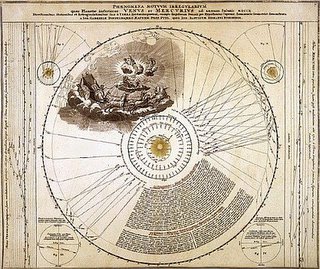


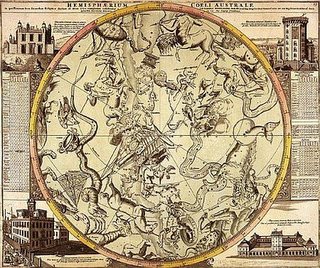
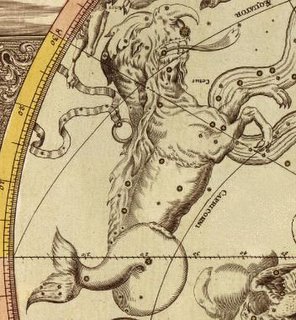
Johann Dopplemayr (1677-1750) studied mathematics, physics and law. He was eventually appointed to the Chair of Mathematics at Aegidien Gymnasium in Nuremburg where he remained for some 50 years until his death.
He wrote a number of publications on geography, mathematical instruments, sundials and trigonometry and most notably compiled a book of historical biographies of 3 centuries of mathematicians from Nuremburg.
Dopplemayr collaborated with cartographer and engraver, Johann Homann for most of his (essentially unoriginal) astronomy publications. The above illustrations come from a work whose title page refers directly to Copernicus and Brahe but a debt is also owed to Pardies, Hevelius and Bayer and likely others - the origins of all the cosmological and astronomical diagrams in Dopplemayr's 1742 Atlas Coelestis is still not completely settled.
Atlas Coelestis in quo Mundus Spectabilis et in eodem Stellarum omnium Phoenomena notabilia, circa ipsarum Lumen, Figuram, Faciem, Motum, Eclipses, Occultationes, Transitus, Magnitudines, Distantias, aliaque secundum Nic. Copernici et ex parte Tychonis de Brahe Hipothesin. Nostri intuitu, specialiter, respectu vero ad apparentias planetarum indagatu possibiles e planetis primariis, et e luna habito, generaliter celeberrimorum astronomorum observationibus graphice descripta exhibentur, cum tabulis majoribus XXX is online at the website of Robert Harry Van Gent.
- A more colourful display of the 30 plates from the book are online at the appropriately titled Atlas Coelestis site.
- The above closeup details were taken from the flash zoom interface of Atlas Coelestis, hosted by the Gallica website of the BNF (thumbnail page).
- Relevant background and further vividly coloured examples from Atlas Coelestis and some other Dopplemayr celestial charts and globes are available at Glazer Gallery.
- Robert Harry Van Gent's homepage on the history of astronomy.
- More history of astronomy link lists.
- Previous astronomy related posts (the ones I remember anyway)
Originally found via the eccentrically impressive MadMeg site, but thanks for the reminder D.
Histoire de Perlette





I didn't find out much regarding this work from illustrator Béatrice Appia (1899-1998). It was released as a part of the Père Castor (Father Castor or Beaver) childrens book series in 1936 by Flammarion Publishers and basically tells of the adventures of a drop of water from cloud to earth and back again. There are about 15 of these lush illustrations in thumbnail format.
Thursday, February 16, 2006
Each In His Own Tongue
A crystal and a cell,--
A jelly-fish and a saurian,
And caves where the cave-men dwell;
Then a sense of law and beauty,
And a face turned from the clod,--
Some call it Evolution,
And others call it God.

The infinite, tender sky,
The ripe, rich tint of the cornfields,
And the wild geese sailing high,--
And all over the upland and lowland
The charm of the goldenrod,--
Some of us call it Autumn,
And others call it God.


When the moon is new and thin,
Into our hearts high yearnings
Come welling and surging in,--
Come from the mystic ocean
Whose rim no foot has trod,--
Some of us call it longing,
And others call it God.

A mother starved for her brood,--
Socrates drinking the hemlock,
And Jesus on the rood;
And millions who, humble and nameless,
The straight, hard pathways plod,--
Some call it Consecration,
And others call it God.

Each In His Own Tongue by William Herbert Carruth (1859 - 1924) : published by Wise-Parlow Co. 1925; illustrator unknown.
The Flying Tissandier Brothers
'Advertisement for aeronaut and balloon manufacturer Henri Lachambre shows a balloon "H. Lachambre" with two passengers floating through a scene of animals, circus performers, and toy balloons.'
 [Aerialist wearing wings strapped to his shoulders
[Aerialist wearing wings strapped to his shoulders and feet while suspended from a balloon]
Woodcut ~1885
 Aérotère
Aérotère'Print shows a boat-like vehicle on wheels with parachutes'
Lithograph by H Francois sometime in 19th century
'French cartoon shows a man riding on a bicycle-like flying machine while looking through a telescope attached to the front. Two balloons, "Veloc[ipedes]" and "Domanie," are attached at front and rear as are propeller-like wheels.'
'Italian political cartoon shows a large balloon ("Politica") in the shape of a man ready to gobble up the moon ("Oriente") defended by a man ("Turco") holding a fork. Other armed men representing the nations of Europe and North Africa are falling off the balloon into the frying pan of war ("Guerra") held by the Roman god Mars ("Marte").' from Papagallo 1880
 Navigation aérienne
Navigation aérienne'Ballon & appareil de direction construit par M. Pompéien-Piraud, inventeur'
Wood engraving print by B Arnaud 1883
'Technical illustration shows early balloon designs: "Lana's aeronautic machine," Montgolfiers' balloon," "Blanchard's balloon," "Garnerin ascending [and] descending" in his parachute, the "Charles & Roberts' balloon" being inflated, the "form of the wings employed by Lunardi," and the "form of the wings employed by Blanchard." ' [detail: 'form of the wing' missing here]
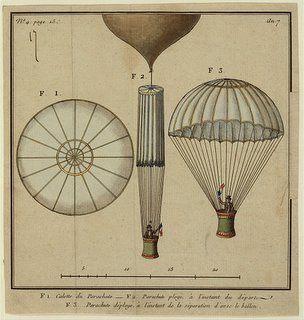 Le premier parachute de Jacques Garnerin, essayé
Le premier parachute de Jacques Garnerin, essayé par lui-même au parc de Mousseaux, le 22 octobre 1797
 Captive balloon with clock face and bell,
Captive balloon with clock face and bell, floating above the Eiffel Tower, Paris, France
Watercolour over graphite by Camille Grávis
The Tissandier brothers, Gaston and Albert, assembled a collection of more than 900 items relating to the early history of aeronautics from various sources. Gaston Tissandier (1843-1899) was a balloonist and science writer. Albert (1839-1906) was a balloonist and illustrator.
"Subjects include general and technical images of balloons, airships, and flying machines; portraits of famous balloonists; views of numerous ascensions, accidents, and world’s fairs; cartoons featuring balloon themes; pictorial and textual broadsides; and colorful ephemera and poster advertisements. There are also several hundred illustrations clipped from books and newspapers. The pictures, created by many different artists, span the years 1773 to 1910, with the bulk dating 1780-1890."
"The collection is rich in images of flights the Tissandier brothers participated in as well as flights they observed between 1865 and 1885. For example, Gaston Tissandier flew over enemy lines during the Siege of Paris in 1870, and Albert made drawings of several balloons that were used to carry passengers and supplies over enemy lines. While Gaston tested the limits of balloon ascension, Albert made drawings of natural phenomena in the upper atmosphere." Together in 1883 they rigged up a Siemens electric engine to an airship and Gaston became the first person to use electric-powered flight.
Gaston, who was a chemist and meteorologist (hence his interest in balloons) and wrote many books, also established the scientific magazine La Nature in which many of Albert's lithographic illustrations were published.
- 450 items from the Tissandier collection have been digitized and posted by the Library of Congress (thumbnail page).
- Background and scope of the collection.
- Biography of Gaston Tissandier.
- Gaston Tissandier at Wikipedia.
- Works by the brothers at Project Gutenburg.
- Previous entries: Tissandier's America & Revisiting Albert Tissandier. Camille Flammarion; Passarola; Albert Robida.
- Complete copies of La Nature between 1873 and 1905 at Le Conservatoire Numérique des Arts & Métiers.
From Aleppo to Jerusalem

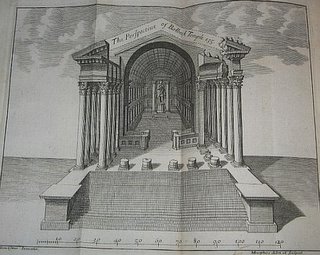
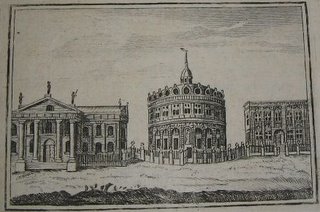

Oxford educated Henry Maundrell (1665-1701) was elected through his uncle's influence to the post of Chaplain at the Levant Company in Aleppo (modern day Syria) in 1695.
In 1697 he went on a 3 month horseback pilgrimage to the Holy Land, passing through Tripoli, Damasacus, Bethlehem, Jerusalem and Latakia, among other places. Maundrell kept a precise yet dispassionate diary of his travels - a factual itemization of the antiquities of the middle east.
" Maundrell carefully recorded meticulous descriptions of castles, mosques, churches, fortresses, aqueducts, wells, rivers, mountains, plains and trails, each complete with measurements, directions, distances, colors, textures and weights."The intention was to circulate copies of his diary among his clerical peers to curry favour with the church heirarchy. But Maundrell's uncle urged his nephew to compile his diary into a book. Although it was published posthumously in 1703, A Journey From Aleppo to Jerusalem At Easter A.D. 1697 quickly established itself as a classic of both travel writing and middle eastern facts. Previous european books about the middle east are said to be notable for their fanciful and inaccurate descriptions.
So influential was the Journey that 7 editions in 4 languages had been released by the middle of the 18th century and it remains a primary historical source in many subject areas relating to the middle east. If you have any interest in middle eastern history the sources below are well worth perusing.






